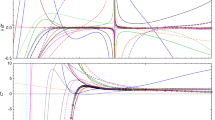Abstract
An optimal algorithm has been developed for calculating the embedding potential in the embedded atom method (EAM) with the aim of describing not only the temperature-dependent density of a liquid metal but also its energy up to its critical temperature. The algorithm is based on the unification of the form of the potential and calculation of its parameters from known density and energy data for the liquid metal. The basis of the algorithm is the use of least squares fitting of the pressure and energy in molecular dynamics simulations to data for a series of states of the liquid along an isobar. To describe liquid potassium, the pair contribution to the potential is represented by a power series in interparticle distance. Data on the properties of potassium at 343, 473, 723, 1000, 1500, 2000, and 2200 K were used. The embedding potential was expanded in terms of 1 − ρ, where ρ is the effective electron density in the EAM. In least squares fitting, fifteen equations were included: eight for the energy and seven for the pressure. The number of unknown coefficients was seven. Iterative calculations allow one to find optimal expansion coefficients and construct equilibrium models through molecular dynamics simulations. It is shown that the discrepancy in energy between simulations and the real metal at high temperatures can be eliminated by taking the electron excitation energy into consideration. The difference between the actual energy of a metal and the energy obtained in EAM simulations is very close to the contribution of the electron heat capacity.
Similar content being viewed by others
References
Belashchenko, D.K., Application of the Embedded Atom Model to Liquid Metals: Liquid Potassium, Zh. Fiz. Khim., 2009, vol. 83, no. 2, pp. 329–333.
Belashchenko, D.K., Application of the Embedded Atom Model to Liquid Metals: Liquid Iron, Zh. Fiz. Khim., 2006, vol. 80, no. 5, pp. 872–883.
Belashchenko, D.K., Application of the Embedded Atom Model to Liquid Metals: Liquid Rubidium, Zh. Fiz. Khim., 2006, vol. 80, no. 10, pp. 1767–1777.
Belashchenko, D.K., Smirnova, D.E., and Ostrovskii, O.I., Molecular Dynamics Simulation of the Thermophysical Properties of Liquid Uranium, Teplofiz. Vys. Temp., 2010, vol. 48, no. 3, pp. 383–395.
Belashchenko, D.K. and Smirnova, D.E., Application of Embedded Atom Model to Liquid Metals: Uranium, XVII Symp. on Thermophysical Properties, Boulder, 2009, p. 346.
Belashchenko, D.K., Application of the Embedded Atom Model to Liquid Metals: Liquid Sodium, Teplofiz. Vys. Temp., 2009, vol. 47, no. 4, pp. 522–535.
Belashchenko, D.K. and Nikitin, N.Yu., Application of the Embedded Atom Model to Liquid Cesium, Zh. Fiz. Khim., 2008, vol. 82, no. 8, pp. 1445–1452.
Finnis, M.W. and Sinclair, J.E., A Simple Empirical N-Body Potential for Transition Metals, Philos. Mag. A, 1984, vol. 50, pp. 45–55.
Daw, M.S. and Baskes, M.I., Embedded-Atom Method: Derivation and Application to Impurities, Surfaces, and Other Defects in Metals, Phys. Rev. B: Condens. Matter Mater. Phys., 1984, vol. 29, no. 12, pp. 6443–6453.
Foiles, S.M., Calculation of Surface Segregation of Ni-Cu Alloys with the Use of the Embedded-Atom Method, Phys. Rev. B: Condens. Matter Mater. Phys., 1985, vol. 32, no. 12, pp. 7685–7693.
Foiles, S.M., Baskes, M.I., and Daw, M.S., Embedded-Atom-Method Functions for the bcc Metals Cu, Ag, Au, Ni, Pd, Pt and Their Alloys, Phys. Rev. B: Condens. Matter Mater. Phys., 1986, vol. 33, no. 12, pp. 7983–7991.
Oh, D.J. and Johnson, R.A., Simple Embedded Atom Method Model for fcc and hcp Metals, J. Mater. Res., 1988, vol. 3, pp. 471–478.
Schommers, W., A Pair Potential for Liquid Rubidium from the Pair Correlation Function, Phys. Lett. A, 1973, vol. 43, pp. 157–158.
Waseda, Y., The Structure of Non-Crystalline Materials: Liquids and Amorphous Solids, New York: McGraw-Hill, 1980.
Belashchenko, D.K. and Smirnova, D.E., Molecular Dynamics Simulation of Liquid Metals at High Pressures: Liquid Potassium, Zh. Phys. Khim., 2011, vol. 85 (in press).
Bystrov, P.I., Kagan, D.N., Krechetova, G.A., and Shpil’rain, E.E., Zhidkometallicheskie teplonositeli teplovykh trub i energeticheskikh ustanovok (Liquid-Metal Heat Transfer Fluids for Heat Pipes and Power Plants), Moscow: Nauka, 1988.
Potassium, in Chemical Elements: Chemistry-files.ru, http://chemfiles.narod.ru/element/k/k.html.
Author information
Authors and Affiliations
Corresponding author
Additional information
Original Russian Text © D.K. Belashchenko, 2011, published in Neorganicheskie Materialy, 2011, Vol. 47, No. 6, pp. 732–737.
Rights and permissions
About this article
Cite this article
Belashchenko, D.K. Optimal algorithm for constructing the embedded atom method potential for liquid metals. Inorg Mater 47, 654–659 (2011). https://doi.org/10.1134/S0020168511060045
Received:
Published:
Issue Date:
DOI: https://doi.org/10.1134/S0020168511060045




